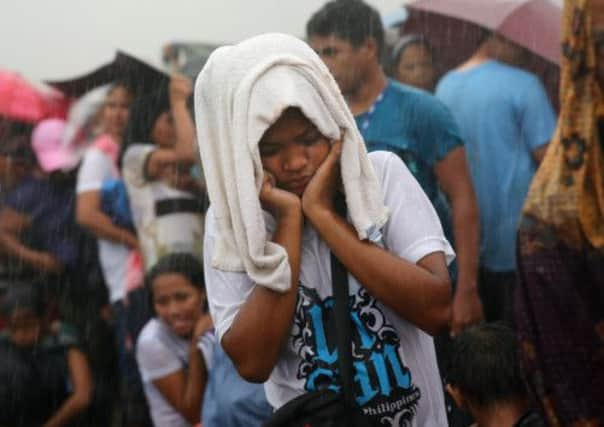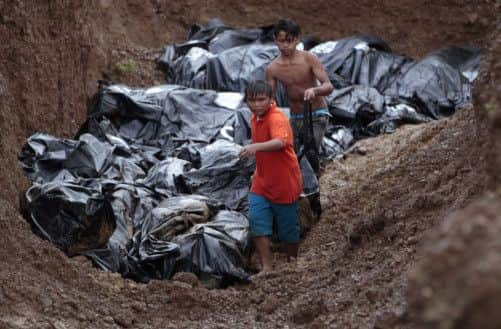Typhoon Haiyan: Tacloban buries the dead


Royal Navy aircraft carrier HMS Illustrious has been sent to the Philippines to help with the relief effort following the devastation caused by Typhoon Haiyan.
Dozens more bodies were lined up in bags outside Tacloban City Hall yesterday waiting to be taken to burial sites.
Advertisement
Hide AdAdvertisement
Hide AdSix days after Haiyan struck the central Philippines, many of the dead were still lying along roads as survivors searched for bodies buried under the rubble.


Philippine soldiers on trucks distributed rice and water as teams with chainsaws cut debris from blocked roads.
Thousands swarmed towards the city’s damaged airport, desperate to leave or to get treatment at a makeshift medical centre.
Authorities said 2,357 people have been confirmed dead, but that figure is expected to rise, perhaps significantly, when information is collected from other areas.
In the city’s first mass burial, scores of bodies in black bags were lowered into graves without prayers being said.
“I hope this is the last time I see something like this,” said mayor Alfred Romualdez.
“When I look at this it just reminds me of what has happened from the day the storm hit until today.”
Officials said efforts had been made to identify the bodies so families have a chance of finding out what happened to their loved ones in the days and weeks to come. It was not immediately clear whether this included DNA testing.
Advertisement
Hide AdAdvertisement
Hide AdA charity appeal to help the 11.5 million people affected by the disaster has raised £23 million in the UK in just two days and the government has now given more than £20m in aid.
HMS Illustrious, the Royal Navy’s only operational aircraft carrier, has a 900-strong crew and seven helicopters to provide assistance, as well as the ability to provide fresh water, vital in the effort to combat the spread of disease.
The vessel, which was taking part in exercises in the Gulf, will arrive in the disaster zone by November 25, replacing HMS Daring which has already been deployed.
Prime Minister David Cameron said: “What happened in the Philippines is an absolute tragedy. You can see the devastation, the suffering, and it’s quite clear that we are going to need long-term help for those people.”
A civilian Antonov cargo aircraft and at least one RAF C-17 transport plane have also been assigned to the relief effort.
International Development Secretary Justine Greening said: “We are now in peak danger period for the spread of infectious disease, so HMS Illustrious’s capability to provide drinking water will be invaluable.”
The American aircraft carrier USS George Washington arrived in the Philippine Sea near the Gulf of Leyte yesterday, and will set up a position off the coast of Samar Island to assess the damage and provide medical and water supplies.
Tacloban city administrator Tecson Lim said 70 per cent of the city’s 220,000 people are in need of emergency assistance and that only 70 of the city’s 2,700 employees have been showing up for work.
Advertisement
Hide AdAdvertisement
Hide AdHe also stuck to an earlier estimate that 10,000 people had died in Tacloban even though president Benigno Aquino III has said the final death toll would be near 2,500.
While there is no shortage of aid – both domestic and international – much of it is stuck in Manila and the nearby airport of Cebu because of the extensive damage that Tacloban airport suffered. Some of it, including food, water and medical supplies from the US, Malaysia and Singapore, has reached Tacloban and is sitting on pallets along the tarmac.
Baroness Amos, the UN humanitarian chief, said some 11.5 million people have been affected by the typhoon, which includes people who lost their loved ones, were injured, and suffered damage to their homes, business or livelihoods.
“The situation is dismal… tens of thousands of people are living in the open… exposed to rain and wind,” she said.
British medical contingent ready to start work
A TEAM of British medics has arrived in the Philippines to help treat survivors.
The 12-strong team of doctors, surgeons and paramedics – which includes a Scot – landed in the capital Manila yesterday as part of Britain’s emergency response to Typhoon Haiyan, the Department for International Development (DFID) said.
Richard Villar, a consultant orthopaedic surgeon based in Cambridge, who has previously led surgical teams in global disaster projects in earthquake-hit Haiti and Kashmir and the East Java mud flow, said: “We must be where we can do the most good for as many distressed people in as short a time as possible.”
Dr Andrew Taylor, a consultant anaesthetist at Maidstone and Tunbridge Wells NHS Trust, said: “We are lucky we live in a country with stable geography.
Advertisement
Hide AdAdvertisement
Hide Ad“I have been trained and have skills that are useful to the locals who are injured. If the situation was reversed I would want someone to come and help my family.”
International Development Secretary Justine Greening approved the deployment of members of the UK International Emergency Trauma Register following a direct request from the Philippines department of health.
Team leader Amy Hughes, who worked as an emergency medicine and pre-hospital care clinician at Derriford hospital, Plymouth, said the medics in the team have a “varied and diverse range of clinical skills” and have undergone training relevant to working in disaster zones.
She added: “This enables us to complement and help strengthen the healthcare already existing, and to work with the local and international teams to help meet the extensive medical and surgical needs resulting from Typhoon Haiyan – whether it be through the provision of medical skills and personnel, equipment or both.”
READ MORE